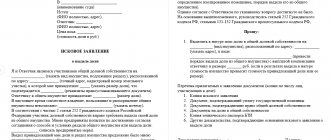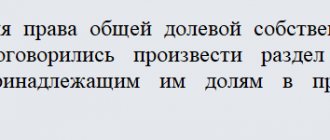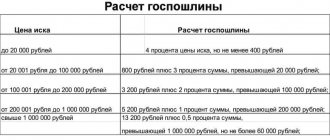Clause 1 of Article 11.2 of the Land Code of the Russian Federation determines the ways in which new units of cadastral registration – plots of land – can arise. One of these methods is the allocation of a land plot - the legally formalized emergence of a smaller plot (or plots) from one large plot. Many owners confuse the consonant terms “allocation” and “division” of plots of land. It is possible to allocate a part only if there are three or more share owners. If there are two owners, then they can only divide the disputed territory. The legal results of these procedures vary.
| Allocation in kind | Chapter | |
| Ownership | Shared ownership is retained, with the exception of the allocated part | Termination of shared or common joint ownership |
| Borders | The shares of the owners are known in advance, the boundaries change in accordance with the shares | The emergence of several independent plots with their own boundaries and separate cadastral numbers |
| Registration procedure | Faster and cheaper | Longer and more expensive |
The reasons for the allocation of land use objects may be different. For example, the owners received their shares as an inheritance. Or the creditor bank demands to allocate the debtor’s share in order to foreclose on it.
The legislator does not allow all land resources to be transferred into ownership. Any transactions for the provision of plots are prohibited in specially protected areas, in nature reserves, on particularly fertile lands and in territories that make up the country’s forest and water resources.
The concept of land allocation
Among the methods of forming land plots, allocation occupies a special place. This is a system of cadastral and land management work associated with the separation of a share or shares from the total land plot in the area. When selected, one or more new objects can be created. In this case, the original area from which the allocation is made continues to exist within the changed boundaries.
Allocation of a land plot is possible when the object being converted is in common shared ownership. This legal regime is regulated by Chapter 16 of the Civil Code of the Russian Federation.
A distinctive feature of shared ownership is that the shares of co-owners are known in advance. In addition, they can be unequal, for example: ½ + ¼ + ¼. For comparison: the shares of joint owners are determined only at the time of division of property. As a general rule they are equal.
A plot can become the object of common shared ownership for various reasons: inheritance, transaction, foreclosure on the debtor’s property.
Co-owners often find it difficult to determine what rights they have to the plot. By default, the shared ownership regime is established (Article 224 of the Civil Code of the Russian Federation). The right of joint ownership is typical for the common property of spouses (by default), for farm assets (by agreement).
The Russian Land Code does not limit the range of possible shareholders. The site being converted may simultaneously be owned by:
- citizens;
- foreigners;
- organizations;
- states;
- municipalities.
Converted and allocated land plots
A land plot is a special object of property rights, which is a part of the earth’s surface with an established border. Its legal regime is determined simultaneously by civil and land legislation. Like other individually defined things, a plot can be divisible or indivisible. According to Art. 133 of the Civil Code of the Russian Federation, property that cannot be divided in kind without changing its intended purpose is recognized as indivisible.
The Land Code of Russia has clarified these requirements in relation to plots. The latter are recognized as divisible if they can be divided into parts, each of which forms a self-sufficient plot, the permitted use of which can be carried out without being transferred to land of a different category. This provision takes on special significance in relation to agricultural land. When selecting, we are talking about the following objects:
- the initial section from which one or more parts are extracted. As a result of the procedure, it does not cease to exist, but is only transformed. The area of such a site decreases, its boundaries change.
- a newly formed plot or plots that did not previously exist as independent objects of civil and land law. They appear in connection with the separation.
For clarity, let us compare the composition of the initial and resulting objects during separation (Article 11.5 of the Land Code of the Russian Federation) and division (Article 11.4 of the Land Code of the Russian Federation). In the latter case, the original plot, which serves as the territorial basis for the placement of newly formed plots, ceases to exist as an independent object of law.
Formation of a land plot by allotment
An exclusive list of methods for creating land plots is stipulated by Art. 11.2 Land Code of the Russian Federation. Among them are:
- the only primary one is the allocation from undemarcated lands that are in municipal or state ownership;
- several secondary ones (section, allocation, merger, redistribution), involving the transformation of existing plots.
Thus, the concept of “allocation of land”, depending on the context, may have a different logical scope.
- Creation of a new object of civil law from virgin lands - previously unused spaces that are in public ownership. Municipal and state owned lands in Russia are still not demarcated. The plots of them have not been formed; they have not been registered with the state real estate cadastre and the Unified State Register of Real Estate. The development of such lands for various purposes (integrated development, laying pipelines, gardening) is inevitably accompanied by the allocation of plots, the definition and recording of their legal regime in the State Property Committee, the Unified State Register.
- Transformation of a land plot owned by two or more shareholders, according to the rules of Article 11.5 of the Land Code of Russia or in accordance with the requirements of Federal Law No. 101 “On the Turnover of Agricultural Land”, the transformation of a land plot is carried out in the process of land management by determining the boundaries of the allocated plot, clarifying the boundaries of the original plots.
How can free land be used?
All of the above categories of citizens can apply to receive free land plots from the state and use them for the following purposes: 1) individual housing construction; 2) gardening; 3) vegetable gardening; 4) personal farming.
In addition to the list of preferential categories of citizens who can receive free land for the above purposes, there are also regional programs for the resettlement and development of various lands. This list includes land plots of the Far Eastern and Crimean lands, and a bill has also been introduced on the allocation of land for migrants from the Far North. The conditions of these programs provide for the free provision of land for development for a certain period, after which the land can be registered as property. The main thing is to comply with the terms of the program: if the land is provided for agriculture or farming, it must be used only for these purposes. In addition to economic activities, land can also be issued for housing construction or business activities.
Sources
- https://ros-nasledstvo.ru/vydel-doli-v-nature-zemelnogo-uchastka-iz-obshhej-dolevoj-sobstvennosti/
- https://estatelegal.ru/zemelnoe-pravo/vydelenie-doli-zemelnogo-uchastka-v-nature/
- https://myrealproperty.ru/zemelnyj-uchastok/mezhevanie/vydel-doli-v-nature.html
- https://vserasskajem.ru/kak-vydelit-zemelnyj-uchastok.html
- https://law-divorce.ru/vydel-doli-v-nature-zemelnogo-uchastka-iz-obshhej-dolevoj-sobstvennosti/
- https://svoyuristonline.ru/oformlenie-zemli/vydel-doli-zemli-v-nature.html
- https://rosreestr.net/info/besplatnye-zemelnye-uchastki-komu-i-na-kakih-usloviyah
[collapse]
Legal consequences of land allocation
The legal consequences of the allocation of a land plot may be as follows:
- The original (transformed) site changes its area and boundaries, otherwise its legal regime remains the same.
- The newly created (allocated) plot is taken into account as an independent property. By default, it acquires the legal regime of the original object: it belongs to the same category and territorial zone, and the same types of uses are allowed in relation to it.
- After the allocation, easements and encumbrances continue to operate within the same legal scope and territorial boundaries.
- The shareholder, upon whose application the plot is allocated, becomes its sole owner. He loses the right of shared ownership of the reduced original plot.
- The remaining shareholders retain their rights to the transformed plot, and their shares increase proportionally. Considering that the area of the common property has decreased, objectively the scope of the rights of the co-owners remains the same, that is, in the event of a division, they will be able to claim the same area as before.
The procedure for allocating a land plot to shared ownership
Art. 252 of the Civil Code of the Russian Federation guarantees the shareholder the opportunity to demand the allocation of his share from the common property. The procedure is carried out on the initiative of one or more co-owners of the site, which is in shared ownership.
To carry out the allocation, the consent of all interested parties is required, including tenants, mortgagees and pledgees (Article 11.2 of the Land Code of the Russian Federation). The opinion of the persons in whose favor the easement is established is not sought.
The allocation of a share of a land plot in kind can be the result of:
- the decision of the shareholders adopted at the general meeting on the application; interested person;
- court verdict.
The decision of the general meeting of shareholders approves:
- land surveying project;
- a list of owners of the created plots, if there are several of them;
- recalculation of shares for the original plot.
If a plot is formed on the basis of a decision of a meeting of shareholders in accordance with the land surveying project approved by this meeting, then additional approval of the location of the boundaries of the new plot is not required. Otherwise, the owner of the allocated share turns to the cadastral engineer. The latter, on a contractual basis, prepares a land surveying project for allocation against the land share.
The size of the allocated plot is determined on the basis of documents certifying the right to a land share. Taking into account the specific configuration of the land plot and the properties of the soil, the final area of the allocated plot may differ from that indicated in the title documents, up or down. Persons whose rights have been violated may request monetary compensation.
Methods for allocating a share
To allocate a share from joint ownership at the request of individual co-owners of a land plot, the consent of all shareholders of the given plot is required.
There are two ways to allocate a share of a plot from joint ownership:
- On a voluntary basis;
- Through the court.
The allocation of a share occurs on a voluntary basis if the co-owners of the plot have no objections to such allocation and all the necessary documents are available for the common plot.
It is necessary to apply to the judicial authorities with a claim for the allocation of a share in the following cases:
- Lack of title documents for the share;
- Incorrect indication of the size of the share in the documents;
- Conflict with co-owners of a common plot;
- Obstruction by local authorities.
It is important to know that legal claims will relate to the allotment procedure only if the shared ownership has already been registered, and claims regarding the size of the resulting shares when dividing plots between heirs or former spouses relate to property disputes and do not lead to the allotment of a share in kind.
Allocation of land through the court
If the shareholders were unable to reach an agreement on the method and conditions for dividing the common plot, the interested party has the right to allocate the land plot through the court on the basis of Art. 252 of the Civil Code of the Russian Federation. Based on the results of the consideration of the case, the court has the right to refuse the plaintiff-shareholder if the allocation is impossible without disproportionate damage to the common property associated with the impossibility or inconvenience of its use for its intended purpose (clauses 35, 36 of the joint Resolution of the Plenum of the Supreme Court and the Supreme Arbitration Court dated 01.07.96 No. 6/8 ).
In case of refusal, the interested party is faced with a choice: to remain a co-owner of the property or to demand monetary compensation from the remaining shareholders. As a general rule, replacing the allocation of a land plot in kind with such compensation requires the initiative of the right holder.
However, the court has the right to make such a decision on its own initiative without the consent of the shareholder if:
- its share is insignificant;
- it cannot be isolated in nature for technical reasons;
- the shareholder is obviously not interested in using the common plot.
If the allocation is carried out through a court, the latter’s verdict is recognized as a document of title and a full replacement for the decision of the general meeting of shareholders for the purposes of state registration.
Conditions
In order to separate a physically separate property from common shared ownership, certain conditions must be met.
- No significant damage to the primary memory. If the original land plot suffers significant damage, the allocation procedure will be declared illegal, or the remaining co-owners may even prohibit the procedure in court.
- In a situation where part of the land proposed for allocation in the total share of property is too small and cannot be physically allocated, the remaining co-owners are obliged to buy out the allocated share (according to clause 4 of Article 252 of the Civil Code of the Russian Federation). In this case, the amount of the ransom is determined by the court or a settlement agreement.
- Unobstructed passage and passage of vehicles must be ensured to each of the secondary storage facilities. In other words, none of the plots should be located inside others, or be cut off from the road, passage, passage by other plots, or by natural barriers.
- All boundaries of secondary landfills should not have common areas (territorial intersections).
In addition, the legislation determines that the actual size of the newly created ZU does not have to be equal to the ideal share. This can happen due to the characteristics of the landscape, when already during demarcation it turns out that some natural obstacle does not allow the site to be allocated strictly according to the proportion (Clause 5 of Article 13 of Federal Law No. 1001).
For example, on the territory of the primary land plot there is a ravine that divides the territory in such a way that when the land is cut according to the allocated share, several square meters remain near the ravine from the land allotment of other owners, access to which is limited by a natural obstacle (ravine). In this case, the cadastral engineer, of course, will cut this part to the allocated memory.
Registration of land allocation
A shareholder interested in the allocation will receive significant relief when registering with the State Property Committee. To form a site you only need:
- application for registration of a newly formed facility;
- documents necessary for its cadastral registration.
The state does not oblige the shareholder who is allocating a land plot to submit an application for registration of changes in the boundaries and area of the converted object (Article 24 No. 221-FZ “On the State Real Estate Cadastre”). Their registration is carried out automatically within three days from the date of state registration of the right to the allocated plot.
The procedure for state registration of land plots by allotment is established by Art. 22.2 of Federal Law No. 122 “On state registration of rights to real estate and transactions with it.” The legal basis may be:
- agreement on the allocation of land plots;
- decision of shareholders to approve the layout of the allocated plot on the cadastral plan of the territory;
- decision on preliminary approval of the provision of a land plot in public ownership;
- decision to seize a site for municipal and state needs;
- court verdict as a self-sufficient legal document.
State registration of the creation of a site is carried out on the basis of an application from an interested person, to which are attached:
- title documentation for the original plot (not provided if the converted object is registered in the Unified State Register);
- notarized consent of copyright holders (tenants, mortgagees and pledgees) for the allocation.
The legal basis for state registration of ownership of a plot formed during the allocation on account of a land share is recognized as documents confirming the ownership of such a share. Attached to them is a photocopy of the minutes of the general meeting of shareholders - co-owners of agricultural land, certified by an authorized official of the municipality, which approved:
- land surveying project;
- list of owners of newly created objects;
- their shares in the common area.
Simultaneously with the registration of ownership of newly formed plots, state registration of existing restrictions and encumbrances is carried out. If the rights to the original (transformed) plot are not registered in the Unified State Register, then they are registered simultaneously with the allotment. It is noteworthy that an entry is made in the register about both new (changed) and old (existing before the allocation) boundaries.
Registration of the allocation of a new object from a land plot that has already been registered in the Unified State Register has the following consequences: the registrar, on his own initiative (without the application of shareholders), enters into the register information about changes in area and shares. In this case, the size of the shares is expressed in simple fractions.
Easement and allocation of shares
If a large plot of land has a border with public land, for example, in the form of a road, then after the division the situation may lead to the fact that access to the new plot will be made only through driving through the old plot. Then the owner of the allocated plot has the right to demand the imposition of an easement. This will allow you to move in and out freely legally on land owned by another owner.
If the permitted use of a land plot allows the construction of a house, and the owners plan to build and then connect the necessary communications, then most likely they will insist on the land that is located closer to the relevant highways. If connection is possible only through the former co-owners, then in this case an easement will be required.
When talking about easements, you need to understand the following points:
- It is not a reason to obtain ownership of a plot of land that is needed for passage or passage.
- It can also be provided for laying communications.
- A change of owners does not affect the easement.
- A record of its imposition is made in the real estate register, the information of which is available to anyone.
Allocation of land from agricultural land
There are many reasons why commercial agriculture involves the use of large areas of land. For example, crop production requires sowing changes, the use of special equipment, and land reclamation work. The specifics of agricultural land are taken into account by the legislator when regulating the procedure for the formation of plots.
The allocation of a land plot from such lands is regulated by Federal Law No. 101 “On the turnover of agricultural lands.” The requirements of the Land Code of the Russian Federation and the relevant law are correlated as general and special. In case of conflict, the law must be applied.
Art. 13 of Federal Law No. 74 “On Peasant (Farm) Farming” guarantees the shareholder the opportunity to demand the allocation of a plot on account of his share that arose during the privatization of agricultural land before the entry into force of Federal Law No. 101 for the creation or expansion of a farm. The specifics of allocating agricultural land must be observed in this case as well.
Many legally significant actions with the land share of agricultural land can be carried out without allocation in kind. Among them:
- transfer to trust management;
- contribution to the authorized capital of an agricultural enterprise using a common plot;
- relinquishment of ownership rights;
- will;
- sale/donation to another shareholder, agricultural enterprise or farm member who uses a common plot.
In order to exercise other powers to dispose of land, the share must be allocated in kind. The procedure is regulated by Art. 13 of Federal Law No. 101. It is established that shareholders have the right to allocate agricultural land as shares if this does not contradict the requirements for the formation of agricultural land stipulated by the relevant Law No. 101.
The key feature of the procedure is the need to take into account the condition of the soil (the rules are approved by the constituent entity of the Russian Federation). To achieve these goals, it is allowed to allocate a plot of larger or smaller area than is assumed by the title documentation. In this case, interested parties have the right to claim additional payment.
The allocation of shares from agricultural lands that are in municipal ownership occurs in accordance with the rules in force for private lands.
According to the Land Code of Russia, unused lands of poorer quality are allocated first.
In relation to agricultural land, there is a specific rule on state registration of rights through Rossreestr or MFC. If the original plot is owned by five or more citizens, the procedure can be carried out at the request of a person authorized by the shareholders.
His rights are confirmed by an extract from the minutes of the general meeting, certified by a municipal official (clause 2.1, article 22.2 of Federal Law No. 122).
Author of the article
Sites of legal entities
The allocation of a share owned by a legal entity is carried out at the request of the executive body, usually the general director.
In order to avoid challenging the allocation, it is advisable to approve the decision on the allocation of a share at a general meeting of participants.
This is the case if several legal entities own one plot. This happens when a large enterprise, for example, a motorcade, was privatized and after privatization was divided into several companies that have their own boxes for storing and servicing cars, their own sites, meters and other facilities. Allocating a plot of land may be necessary for business purposes, in order to install your own security system, prepare a company for sale, protect against raiding, etc.
Sometimes the entire land plot belongs to one LLC, but its participant wants to leave the LLC and receive his share in kind, for example, one building and the plot under it from a complex of buildings.
He has the right to do this in cases provided for by the charter and the law, however, this will not be an allotment, but a division of the plot.
To allocate a share in the property of an LLC, the procedure will differ as follows:
- the powers of the applicant (director) are certified by an extract from the Unified State Register of Legal Entities (Unified State Register of Legal Entities);
- the organization pays a higher registration fee;
- Disputes regarding allocation are, as a rule, considered not in district courts, but in arbitration courts.











